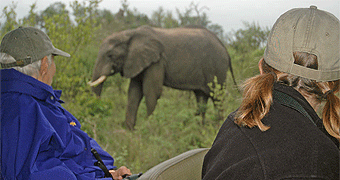
|
|
Mwaluganje Elephant Sanctuary — Kenya Mwaluganje Elephant Sanctuary View Rates, Discounted Prices - Book & Save Now! Mwaluganje Elephant Sanctuary is located in East Africa, in the Kwale District of Kenya's Coastal Province, and is a mere 45 kilometers southwest of Mombasa. The sanctuary has an area of 36 km², and it, along with the adjacent Shimba Hills National Reserve combine to form the Shimba Hills Ecosystem.
The Mwaluganje forest is part of the current sanctuary, and the beautiful Mwaluganje Travelers Tented Camp is in the forest reserve. The ecological attractions in Mwaluganje Elephant Sanctuary are diverse with scenic beauty such as the great natural forests, awe-inspiring cliffs and the warm blue Indian Ocean.
Other natural attractions are "God's Bridge," "Time Rock" and the traditional shrine that characterizes the sacredness of the community.
Mwaluganje Elephant Sanctuary was created in 1993 to conserve the serene surroundings, which house the rare and endangered African elephants, moist deciduous forest, riparian vegetation, and other special attractions available in the ecosystem.
The interior of its trunk (reaching up to 9 meters (30 feet) in diameter) and the lower branches are soft and spongy and can store large quantities of water. Baobabs are specially adapted for long dry seasons. They are leafless during this time of year, thus reducing transpiration or water loss. The baobab is an extremely slow growing tree, reaching up to 18 meters (60 feet) in height.
Truly giant specimens may be several thousand years old. Bats pollinate the flowers of the baobab, and many other animals depend on the unique tree for food and shelter. Look out for them in the Mwaluganje Elephant Sanctuary.
The Scenic Landscape: Mwaluganje Elephant Sanctuary valleys overlooking the Taita Hills are a sight to behold with quite flowing waters and serene surroundings it almost like in paradise. These beautiful hills roll up to Tsavo National Parks to the East and the Indian Ocean to the west, and are marked by striking features like the: Golini cliffs, Kitanze Falls, Manolo River, which consists of the Riverine vegetation and Meandering Rivers.
Educational Experience: Mwaluganje Elephant Sanctuary was launched in the early '90's largely to reduce local human/elephant conflicts, which were on the rise due to both more elephants and more people. Elephants would destroy crops and people would retaliate.
More than 200 families have voluntarily contributed land to the reserve, agreeing not to farm this important elephant habitat. Today, they live nearby and manage the sanctuary, earning more from tourism than from farming, a critical factor in ensuring the survival of these elephants. The sanctuary has also enabled the community to build school classrooms and enjoy a steady water supply and better roads.
Mwaluganje Elephant Sanctuary is currently receiving support from Eden Wildlife Trust, Born Free Foundation, East African Wildlife Society and Pact Inc to build the community's capacity to run the sanctuary sustainable for the benefit of present and future generation.
Booking & Reservations for Mwaluganje Elephant Game Sanctuary Safaris from Mombasa - Kenya Booking Office Tel: + 254 718-179-967 Mobile
: 0721242711 - Kenya
Email: [email protected]
|
|
Concerned
About the Security of Your Booking and Your Own Safety While on
Safari?
African Spice Safaris is a member of the Kenya Association of Tour Operators bonding scheme, backed by a leading insurance company, to ensure your payments are fully protected if a bonded KATO member ceases trading. |
African Spice Safaris New Muthaiga-Nairobi |
Post Office Box 31132 - 00600 |
Email Address info[at]africanspicesafaris.com |
Business Telephone + 254 - (0) - 721-242-711 | + 254 718-179-967 |






